 |
 |
 |
| |
Week 24 and End of Treatment Response for Direct Acting Antiviral (DAA)-Based Therapy in Veterans With Chronic Hepatitis C
|
| |
| |
Following these several opening paragraphs is the poster full text on HCV treatment of 859 vets presented at AASLD.
After reporting this information below I was recently told the 12% HCV treatment number in the VA was old (2005) but a more recent figure is 25%, to which I responded this is also very low. At AASLD there was a poster titled "Week 24 and End of Treatment Response for Direct Acting Antiviral (DAA)-Based Therapy in Veterans With Chronic Hepatitis C" by Lisa Backus MD presumably of the VA in Stanford California, attached is the full poster report wherein they report on 859 vets, 661 receiving boceprevir, 198 receiving telaprevir, 80% (532) of BOC & 81% (160) of TVR patients had ended treatment; overall, 69% of BOC patients & 64% of TVR patients were 'undetectable' at week 24 (p=0.15) and 60% of BOC & 55% of TVR patients were 'undetectable' at EOT (p=0.25) to which the poster says this cohort treated with DAA-based regimens had 'robust week 24 and EOT response rates....higher than those previously seen in the VA in the pre-DAA era'. To which I say these response rates are not robust, not very good, despite that I imagine the response by the VA to me would be the patient population in the VA is a hard to treat group with lots of barriers to successful completion of therapy like depression etc. It appears that this poster is a small representation of a very large HCV+ population in the VA, 859 treated vets out of according to article below 99,000 total vets with HCV systemwide, so to me such a small group chosen, some might say cherrypicked, upon which to report does not represent how the overall VA addresses HCV care & treatment. At IDSA in October there was this report from Boston: IDSA: [poor] Quality of Hepatitis C care at an urban tertiary medical center - (10/19/12). At AASLD I spoke with well meaning clinicians from public hospitals dealing with difficult to treat patient populations from several inner cities and with leading thought leaders in large university-based inner city clinics, and despite at times best efforts by many of them it is clear we have an inadequate infrastructure in the USA to provide the care & treatment that we anticipate will develop in the near future when more highly effective treatment becomes available within 2 years. On top of that it is broadly estimated & accepted that 80% of people infected with HCV remain undiagnosed and we do not have yet a commitment to HCV screening nor linkage to care & support for those patients who need that. So from where & how will we develop these infrastructures, as of now these remain unaddressed questions still however being discussed among key people. A major part of this concern is there is no federal resolve to provide the funding necessary for the programs to address the public health & welfare needs regarding this disease, HCV, for which we will soon 12 week 95-100% cure rates available in the pharmacy. Nor is there such a resolve in general from the states. Even in the best of economic times HCV was dismissed by Congress & the serial administrations in DC regarding actually putting funding into programs despite advocacy, although not like the 90s & HIV. So in these worst of economic times what can we expect from Congress & the Administration, increased taxes or not increased taxes, increased revenues ?? but will we ever see the $100 million needed for HCV? I have doubts, HIV Ryan White brings $1 billion to the table annually.
Jules Levin, NATAP
Gaps in the achievement of effectiveness of HCV treatment in national VA practice - "overall effectiveness of HCV therapy is low in a national sample of veterans with chronic HCV"
http://www.natap.org/2012/HCV/012312_03.htm
Journal of Hepatology February 2012
Jennifer R. Kramer1,2,, Fasiha Kanwal4, Peter Richardson1,2, Minghua Mei1,2, Hashem B. El-Serag1,2,3
1Houston VA Health Services Research and Development Center of Excellence, Michael E. DeBakey VA Medical Center, Houston, TX, United States
There is a chasm between efficacy and effectiveness of antiviral treatment in the VA........."In conclusion, overall effectiveness of HCV therapy is low in a national sample of veterans with chronic HCV......There were 99,166 patients in the study cohort.....Using the nationwide VA HCV Clinical Case Registry (CCR), we examined a cohort of veterans who had HCV viremia between 2000 and 2005 and identified patients who received pegylated-interferon (PEG-INF) and ribavirin......Potential explanations for this include racial diversity and low treatment receipt and completion rates. We can use this knowledge to target interventions such as, improving depression management to increase treatment rates, or introducing a clinical reminder to conduct genotype testing with the hope that these efforts will improve the effectiveness of HCV treatment and, ultimately, reduce the burden of liver disease in the VA......our data show that antiviral treatment has been minimally effective in reducing the burden of HCV-related chronic liver disease. Most of the drop in effectiveness resulted from low treatment rates (12.7%); high treatment discontinuation rates (16.3%); and low response to therapy (23.6% and 50.6%).......Among patients who received at least one PEG-IFN treatment, we found SVRs of 23.6% for genotype 1 or 4 and 50.6% for genotype 2 or 3, whereas RCTs with combination therapy have published SVR rates as high as 52% in genotype 1 and 80% for genotype 2 or 3 [5], [6], [7]. However, the patients in our study were older (49 vs. 43years old); disproportionately African Americans and Hispanics; and adhered less to treatment (as suggested by lower treatment completion rates) than patients enrolled in clinical trials.....our study population was overrepresented with African American men who are generally more difficult to cure compared to the general population, thus, generalizability to other medical systems may be limited. However, the study population of close to 100,000 patients represents more than 3% of the estimated number of patients with chronic HCV infection in the United States and close to 10% of patients with known infection since only one-third to one-half of patients with HCV infection have been identified. The VA also represents the largest integrated healthcare system in the United States and with the availability of the comprehensive HCV registry data it is an ideal population for this "real world" descriptive study.
This letter of comment on this study above was published recently. When I initially reported this published Commentary the response I got was this is NOT true in the VA, so I want to be clear that this occurrence reported in this journal in a letter was said not to be true; nonetheless HCV care in the VA is quoted above by the authors of the paper who are actually VA doctors as saying 'overall effectiveness is low':
Why 88% of US military veterans with HCV are not treated
Journal of Hepatology October 2012
Bennet Cecil
Hepatitis C Treatment Centers, 1009A Dupont Square N,
Louisville, KY 40207, USA
To the Editor:
The article in the February issue of the Journal of Hepatology reported that less than 12% of American military veterans identified with HCV were treated with antiviral therapy [1]. The Veterans Administration does not want to spend adequate funds to cure patients with hepatitis C. Dr. Kenneth Kizer, Under Secretary for Health in the US Department of Veterans Affairs (VA), gave HCV a high priority but unfortunately he left the VA in 1999. Subsequent leadership has not shown enthusiasm for treating HCV.
The Director of Pharmacy and the Chief of Staff at my local VA hospital told me that I spent too much money treating HCV. Boceprevir and telaprevir are both on the hospital formulary but telaprevir prescriptions are routinely denied because it is more expensive. Patients must jump multiple hurdles before qualifying for antiviral therapy. No one would refuse to give coronary artery stents or bypass grafts to a veteran who smokes but veterans who do not completely abstain from alcohol for three months are refused antiviral therapy. In spite of difficulties, 585 of 1372 (43%) HCV RNA positive patients received antiviral therapy between 1998 and 2010 at our local VA hospital; 226 of 583 treated (39%) achieved SVR [2]. 36% of deaths were from HCC or liver failure. Veterans with sustained viral response had substantially improved survival. Effective antiviral therapy improves prognosis [3], [4]. Less than 2% of Americans die from liver disease, but more than one third of veterans with HCV die prematurely from complications of cirrhosis [2], [5]. According to a 2010 national VA report, deaths in veterans with HCV have more than tripled, "Between 2000 and 2008, the annual number of all cause deaths recorded for Veterans with chronic HCV rose from 1259 (1129 per 100,000 in VHA care) to 5967 (4049 per 100,000 in VHA care), respectively" [6].
Legislation should be passed allowing veterans with HCV to prequalify for their choice of Medicaid or Medicare so that they can obtain antiviral therapy in the private sector. Since Dr. Kizer is no longer in charge of the VA, it is very clear that the VA is not going to treat very many of them.
---------------------------------------------------------------
Reported by Jules Levin
AASLD Nov 9-13 2012 Boston
Lisa Backus, MD, PhD12, Pamela Belperio, PharmD1, IChun Thomas, MS1, Ramsey Cheung, MD23, and Larry Mole PharmD1, 1Population Health Office/Office of Public Health, 2Veterans Health Administration Palo Alto, 3 Stanford University Medical Center
Lisa Backus, Palo Alto, 650-493-5000, email: lisa.backus@va.gov
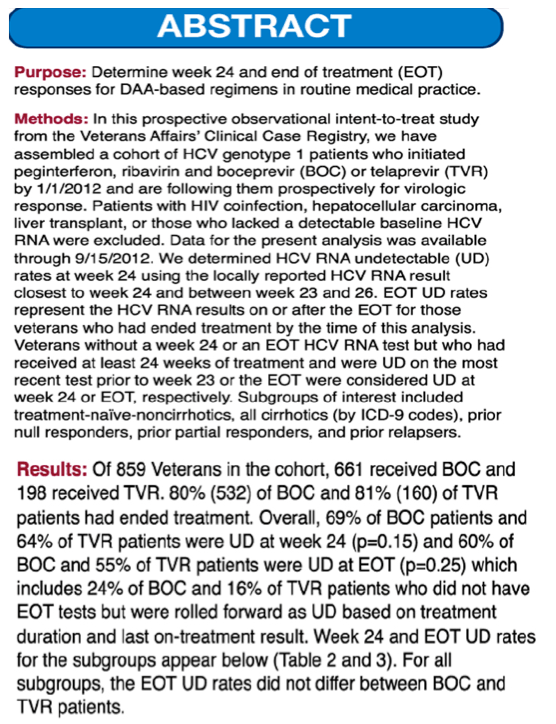
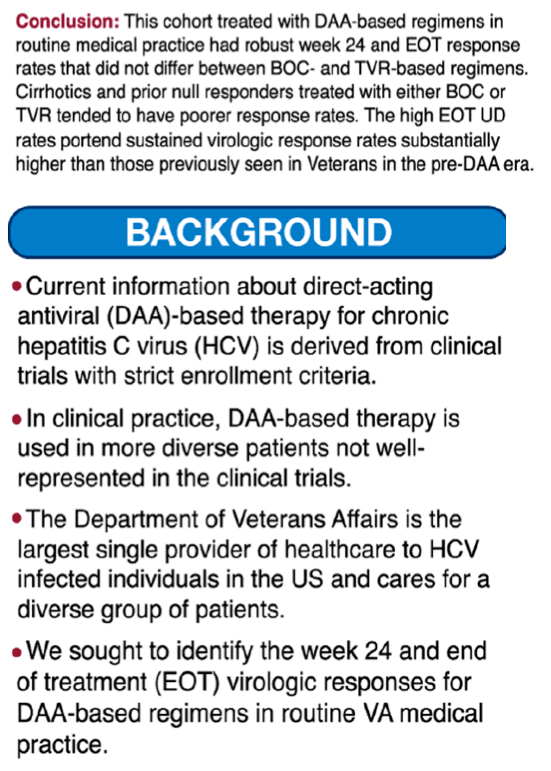
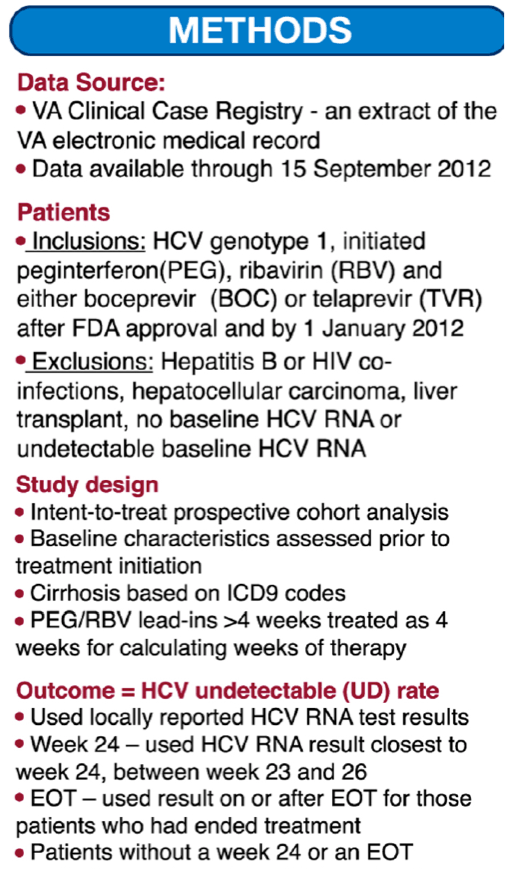
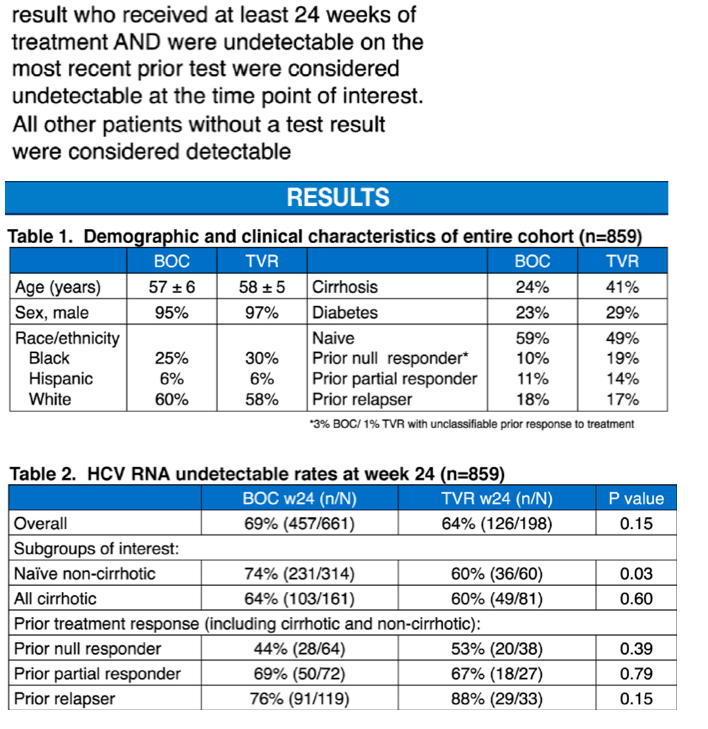
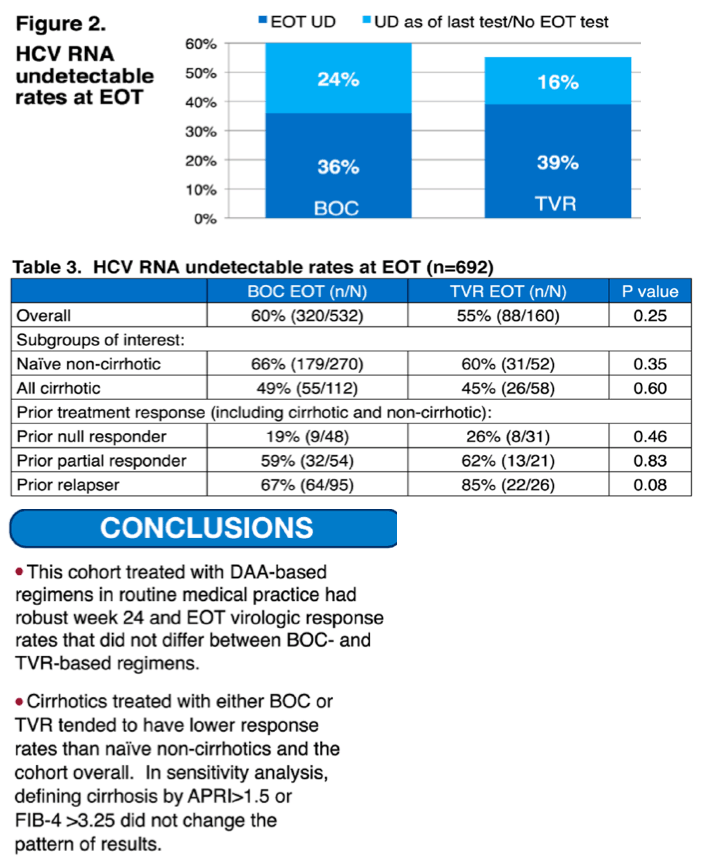
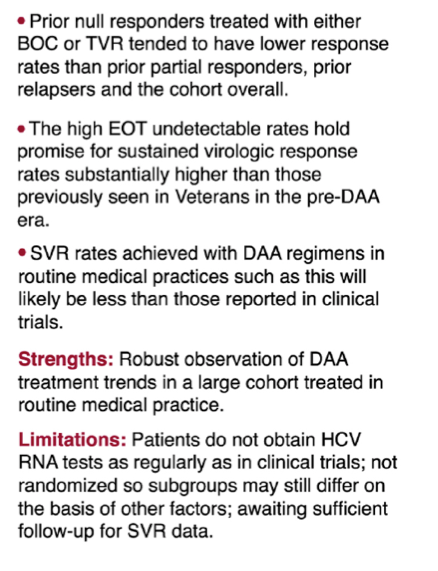
|
| |
|
 |
 |
|
|